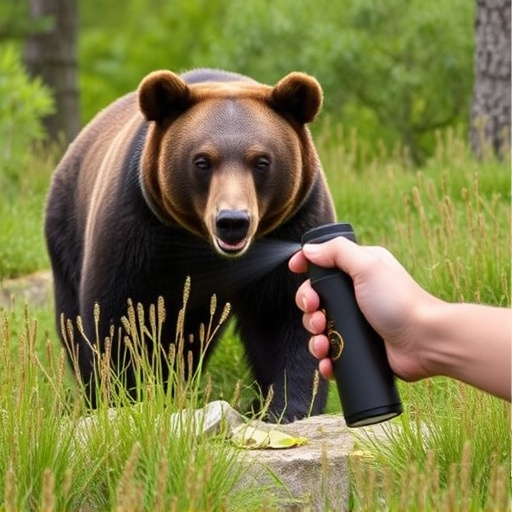Understanding bear spray cloud dispersal range (20-30 feet) is vital for effective use during hiking in bear country. Proper application involves aiming at eyes, nose, mouth and conducting mock sprays before encounters. Choose between aerosol or foam spray based on terrain, bear activity, and personal preference for optimal protection.
When venturing into bear country, packing a bear repellent spray is no longer an option—it’s a necessity. Understanding the critical role of bear spray begins with grasping its cloud dispersal range and effectiveness as a deterrent. This article delves into the essentiality of bear repellent spray for hikers, offering strategies for optimal use and comparing different types to ensure maximum protection during your outdoor adventures.
- Understanding Bear Spray Cloud Dispersal Range
- Why Bear Repellent Spray is Hiking Essential
- Effective Use Strategies for Maximum Protection
- Comparing Bear Spray Types and Their Efficacy
Understanding Bear Spray Cloud Dispersal Range
When considering the effectiveness of bear repellent spray, one crucial factor to understand is the Bear Spray Cloud Dispersal Range. This term refers to the distance at which the spray can reach and create an effective barrier against bears. It’s not just about spraying directly into an approaching bear’s face; rather, it’s about creating a protective zone around you.
The ideal Bear Spray Cloud Dispersal Range is typically around 20-30 feet (6-9 meters), ensuring that the spray reaches the bear and lingers in the air to deter its movement. This range varies based on factors like wind speed, terrain, and the specific properties of the spray. Understanding this dispersal range allows hikers to choose appropriate locations for application during encounters, maximizing their protection while hiking in bear country.
Why Bear Repellent Spray is Hiking Essential
Hiking in bear country? Then carrying bear repellent spray is not just recommended—it’s essential for your safety and peace of mind. Bears are unpredictable, and encounters can quickly turn dangerous if they perceive you as a threat or a food source. Bear spray offers a non-lethal means to deter an aggressive bear by creating a cloud of irritants that disrupt its sense of smell and vision, allowing you time to escape.
The effectiveness of bear repellent spray relies on proper usage and understanding the product’s cloud dispersal range. Typically, a good-quality bear spray can create a protective barrier up to 20 feet (6 meters) in ideal conditions. This range ensures that if a bear comes into contact with the spray particles, it will be temporarily disoriented and less likely to charge towards you or your group. Remember, knowledge of how to use the spray correctly is key to its success during a potential encounter.
Effective Use Strategies for Maximum Protection
To ensure maximum protection while hiking in bear country, understanding effective use strategies for bear repellent spray is paramount. For optimal results, aim for a bear spray cloud dispersal range of approximately 20 feet (6 meters) when spraying. This ensures that the spray reaches the bear’s face and respiratory system, creating a deterrent effect. It’s crucial to target the bear’s eyes, nose, and mouth directly as these areas are most sensitive to the irritants in the spray.
Practice makes perfect. Before heading into the wilderness, conduct mock sprays to familiarize yourself with the spray’s distribution and canisters’ range. This preparation is essential, given that using bear repellent spray incorrectly or at an inadequate range may not deter an aggressive bear effectively. Remember, timing is critical; use the spray promptly when a bear is spotted, and follow up with loud noises and other deterrents if needed.
Comparing Bear Spray Types and Their Efficacy
When it comes to bear spray, not all options are created equal. Understanding the differences in their cloud dispersal range and efficacy is crucial for hikers and outdoor enthusiasts navigating bear country. Two common types dominate the market: aerosol and foam. Aerosol sprays produce a fine mist that can travel up to 20 feet, ensuring coverage over a broader area. This makes them ideal for quick reactions during unexpected encounters. On the other hand, foam bear spray creates a thicker cloud that sticks to surfaces, offering longer-lasting protection at closer ranges—typically around 15 feet.
The choice between these depends on individual preferences and specific hiking scenarios. For areas known for aggressive bears or fast-moving situations, aerosol sprays provide a safer bet due to their quick dissemination range. In contrast, foam sprays excel in denser vegetation where proximity is higher, offering a more targeted defense. Always consider factors like bear activity levels, terrain, and personal comfort when selecting the most suitable bear spray type for your hike.
Bear repellent spray has established itself as a hiking essential, offering crucial protection against potential bear encounters. Understanding the Bear Spray Cloud Dispersal Range is key to effective usage. With the right strategies and knowledge about various bear spray types, hikers can enhance their safety in bear country. By following these guidelines, you’ll be well-equipped to navigate and appreciate the wilderness responsibly.
